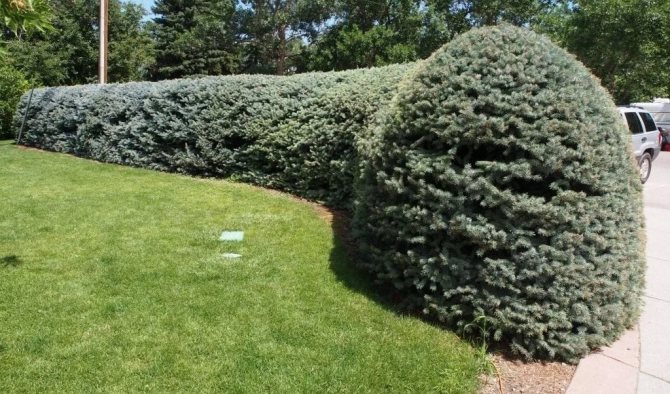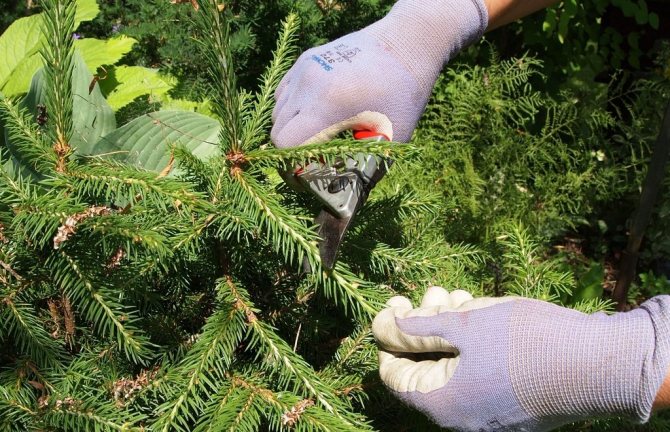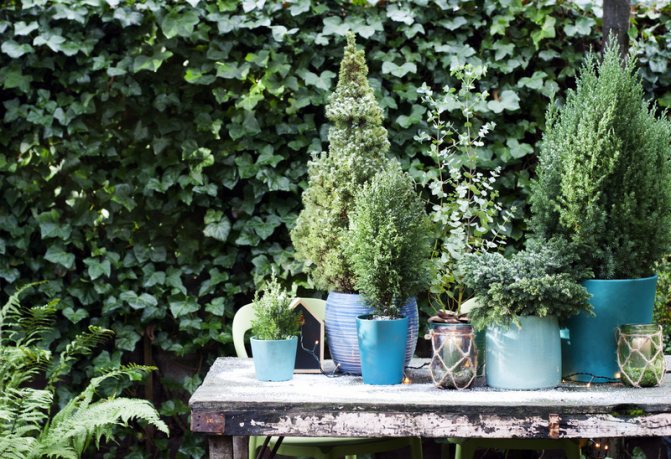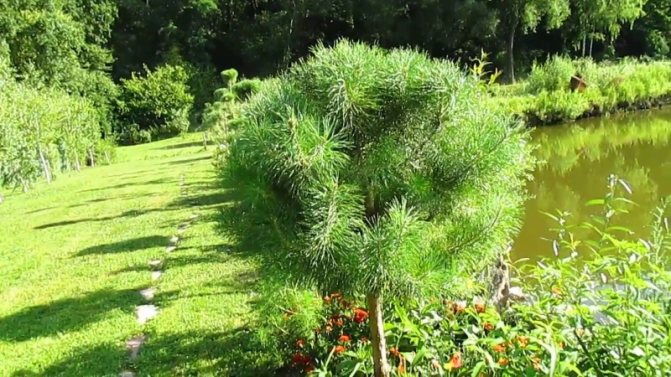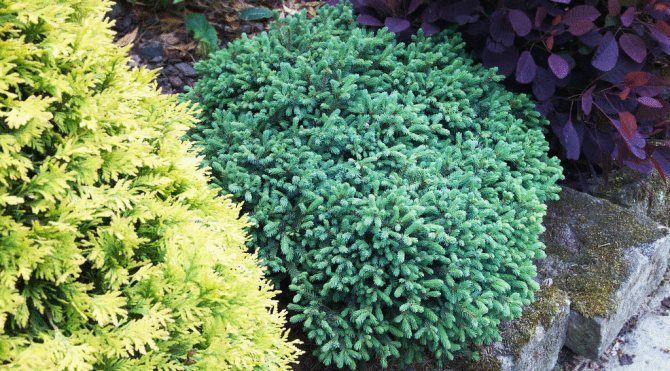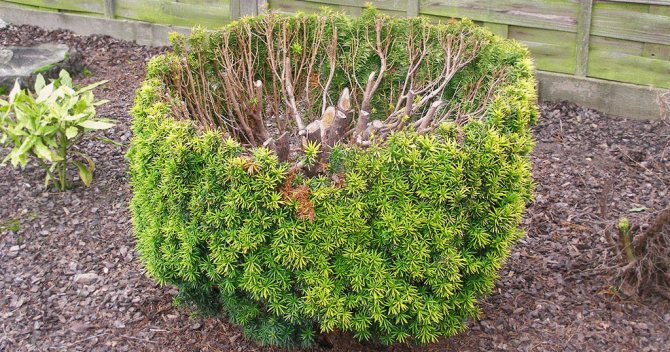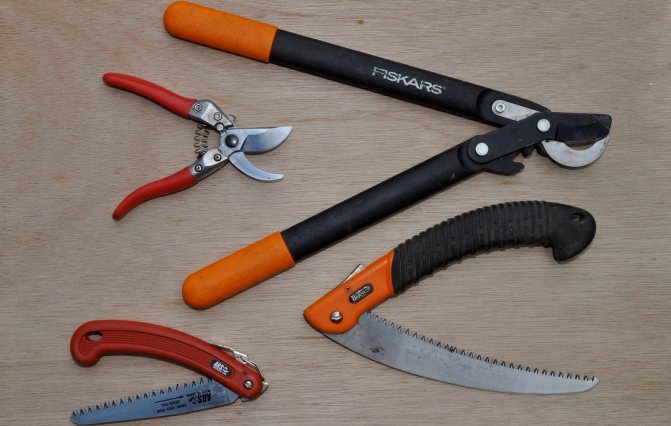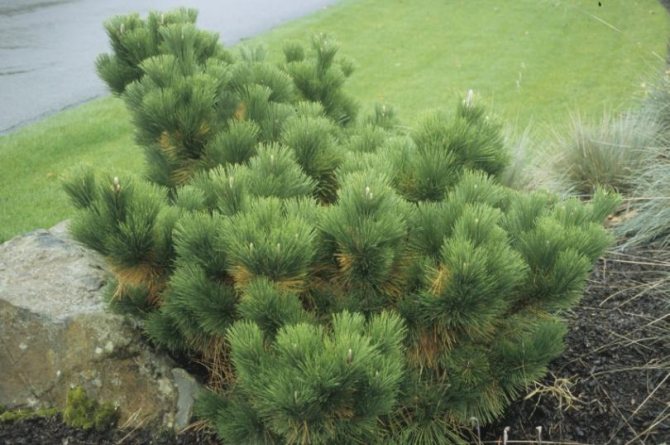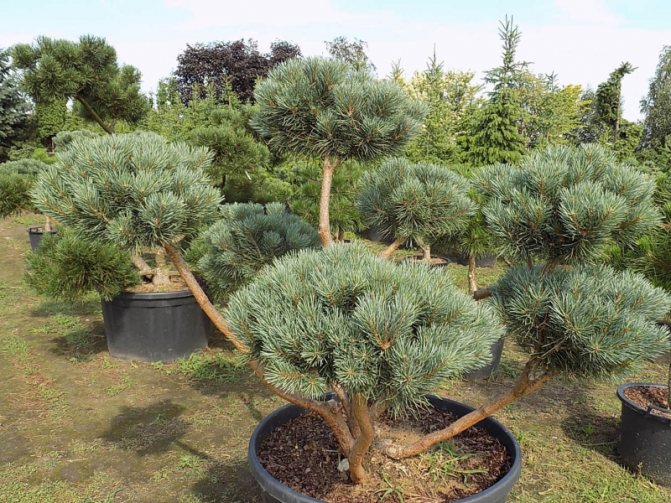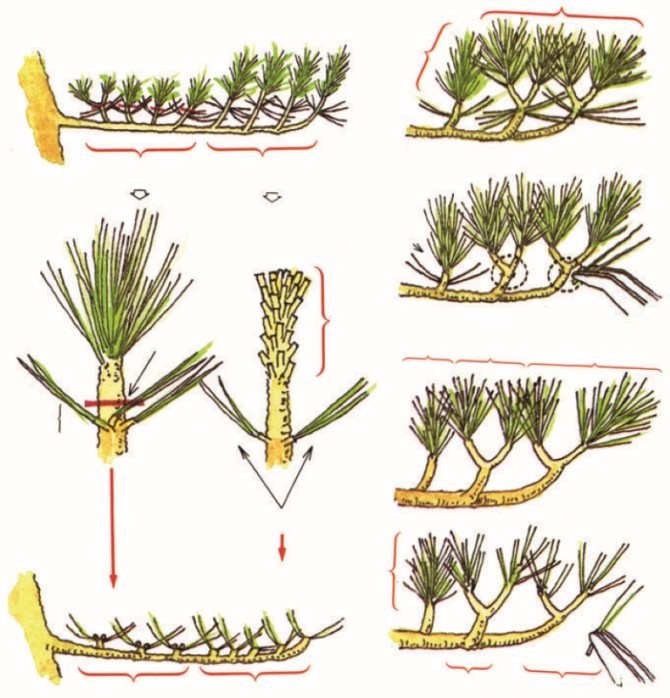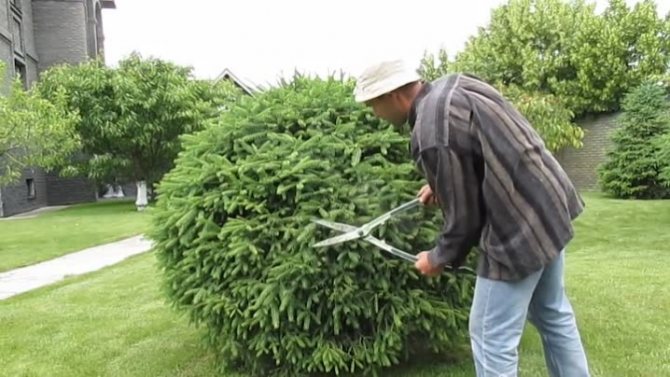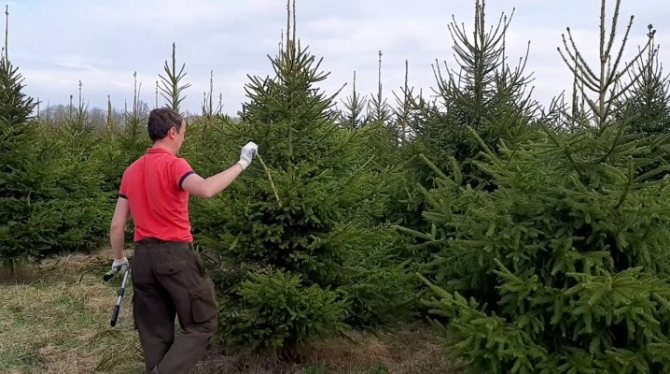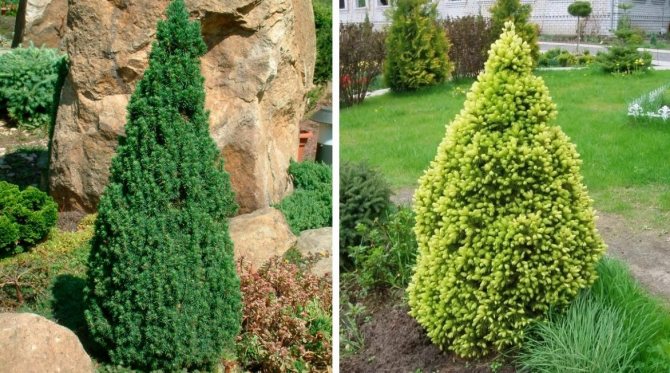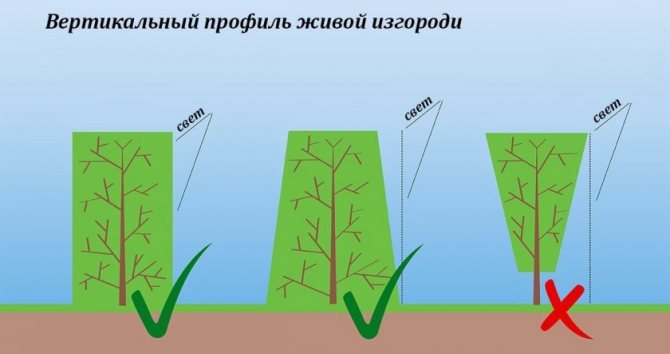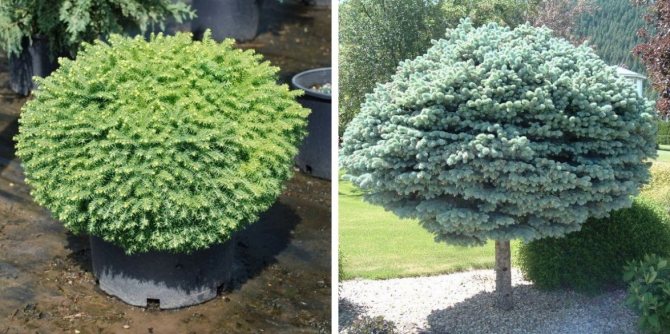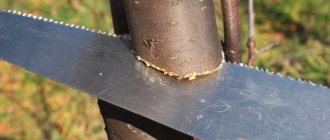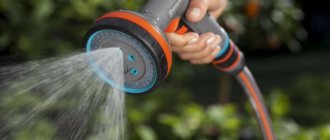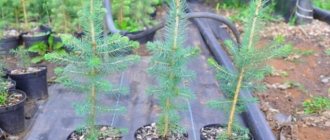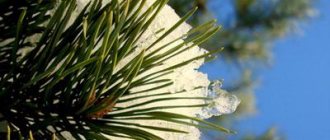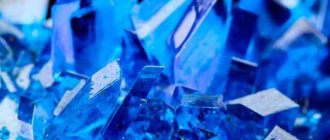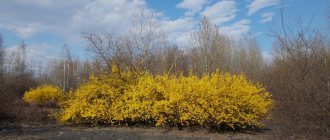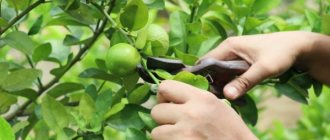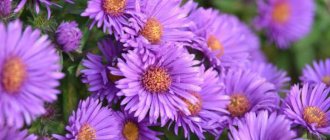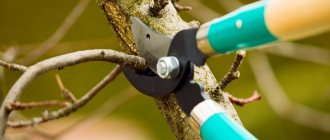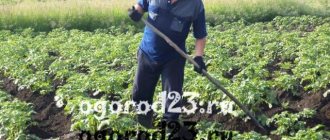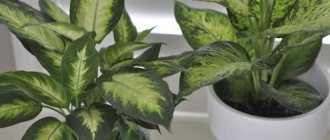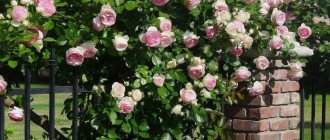How to properly prune conifers
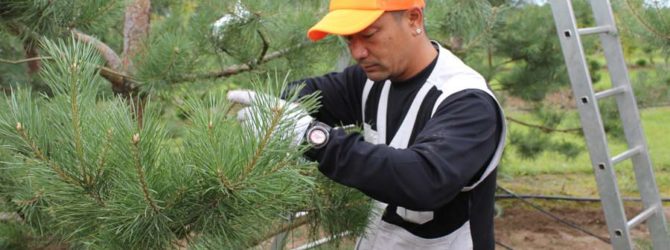
Popularity and attractiveness conifers is based on the fact that, having a high decorative effect throughout the year, they imply low operating costs, time and money for maintenance. Many conifers come from regions with low rainfall, poor soil characteristics and extreme temperature changes, therefore they are considered hardy and undemanding plants. All they need is a little periodic pruning to help keep them healthy and highly decorative.
When you think about pruning any plant, especially conifers, remember the old adage: "Measure seven times, cut once." It is not necessary to measure seven times, two is enough. Because you should answer yourself two important questions: "Why do I want to cut this ephedra?" and "What is this plant and what are the rules for pruning it?" Only by knowing the answers to both of these questions will you be able to prune without harming the plants.
First ask yourself why?
Never prune conifers just like that. It must be remembered that they do not have the same recreational ability to give new growth as other trees and shrubs, so pruning is always done for specific purposes. Namely…
Shaping
Many people want high decorativeness and unusual shapes from their conifers. Carried away by the formation of a pyramidal, spherical or other shape of an object, one should not mindlessly get carried away so as not to make a nondescript bush out of a beautiful tree.
Dimension control
In a sense, this is the weakest reason for pruning. Once the right tree is planted in the right place, its size shouldn't be an issue. However, novice gardeners often find themselves in a position where the tree is growing faster than expected, and it becomes necessary to keep the size of this conifer within the required limits.
Wellness
Removal of dead, diseased or damaged branches should be carried out at any time, as soon as a problem arises and conditions so that it can be safely removed. Removing branches that cross and potentially rub against each other is important because these injuries can be the starting point for serious illness.
Rehabilitation
With rare exceptions, conifers do not give a mass of branches again if it is cut out. This is in contrast to many deciduous trees and shrubs. However, to restore old, ugly conifers, use some creative pruning techniques to achieve a pleasing appearance.
Features of pruning different conifers Conifers include a wide variety of plants, all with different types of needles, and reacting differently to pruning. This is due to differences in the structure of growth: how and when a tree gives new buds, experiences growth shocks, or, conversely, stops growing. When you prune a coniferous plant, the specifics of this process largely depend on these growth patterns, and therefore on the specific conifer. Here are some identification tips and guidelines to follow when pruning the most common conifers.
Pruning conifers with fan-shaped needles: thuja, juniper, etc.
The structure of the needles in such plants is relatively soft; they are fanned along the stems. The foliage (of which the needles are a modification) feels scaly to the touch. Plants can be pruned during the growth activation period in late spring or early summer.
Unlike some conifers, these trees and shrubs will not bud on old wood. If you are cutting old stems, do not think that something will grow on them again. As a rule, pruning of such plants is done to control the size and shape, therefore, it can only be carried out during the period of growth activation, when the stems are still green and pliable.
Pruning conifers with flat needles: hemlock, yew, juniper, etc.
To help these trees form into formal hedges, or to encourage lushness and fullness, their outer growth should be slightly restricted using hand pruners or hedge shears. These conifers are characterized by a burst of growth after pruning, so the best time to trim is when they are not actively growing and are actually "sleeping". That is, in winter or early autumn.
Pruning of conifers with rope-like sharp needles: pine, fir, spruce, etc.
Pines are pruned during the period of active shoot growth, because then they get enough time to prepare for active bud formation for next year's growth. Young shoots of the current year are simply cut off to the desired length.
Spruce and fir are pruned dormant in winter or late summer. These conifers form buds along the stems, so make the cut a centimeter or so above the bud. The topmost bud will become the new leader and sprout. Pruning will also stimulate the outer growth of the needles below the kidneys.
Pruning conifers - when and how to do it correctly?
An adult tree tolerates any pruning quite hard, even if it is planned to simply remove dry, diseased branches or those damaged by pests from the crown.
Therefore, before starting the procedure for pruning conifers and trees, you should examine them well and decide whether such a procedure is really needed.
It is not necessary to prune conifers annually. Unless in order to remove diseased and damaged branches, pruning should be resorted to every year.
The formation of the crown of a coniferous tree should be started when it is planned to use the tree as a hedge or as a landscape decoration, for example, to make a spherical or pyramidal crown.
Regardless of whether it is a coniferous tree or a shrub, they have the same pruning procedure.
Pine sanitary care
To eliminate dead and diseased branches, sanitary pruning is used. This pruning is done as needed. If dead branches remain on the tree, it can lead to illness. Branches are often damaged by strong winds and rain. In order for the branches not to spoil the tree, and also not to create dangerous situations for those around them, they must be removed. To heal the tree, it is recommended to remove the shoots that are tightly pressed against each other. With this arrangement, the branches are injured and can become a source of disease development.
When is coniferous trees and shrubs pruned?
It is recommended to prune conifers and shrubs at the end of winter or early spring in order to stimulate lush and healthy branches in spring, and to reduce the risk of various types of fungal diseases at this time of the year.
After all, the bark is more vulnerable at the time when the period of development of the tree begins. a lot depends on when the pruning of conifers and shrubs is carried out, the time of their development, the spread of the crown and much more.
There is a catch in that most conifers cannot withstand serious pruning.The only exception is one coniferous plant - yew. He is the strongest and most hardy species of conifers.
In the process of pruning, green foliage can be taken into account, but it is not advisable to touch the brown areas of adult plants, since these places are not ways to restore. From which it follows that the tree will lose its attractiveness.
How to properly prune conifers on the site?
How to properly prune conifers with your own hands in a personal plot? here a lot depends on the type of wood and its biological characteristics. You should also cut off those conifers that were not so long ago grafted and grow incorrectly. The aim of pruning is to balance growth.
So, for example, pruning a prickly spruce that has recently been planted will prevent the formation of several tops, which can suddenly grow in different directions and interfere with each other. In this type of conifers, only the side branches should be pruned and the shoots should be shortened so that the shape of the crown of the tree is more like a pyramid.
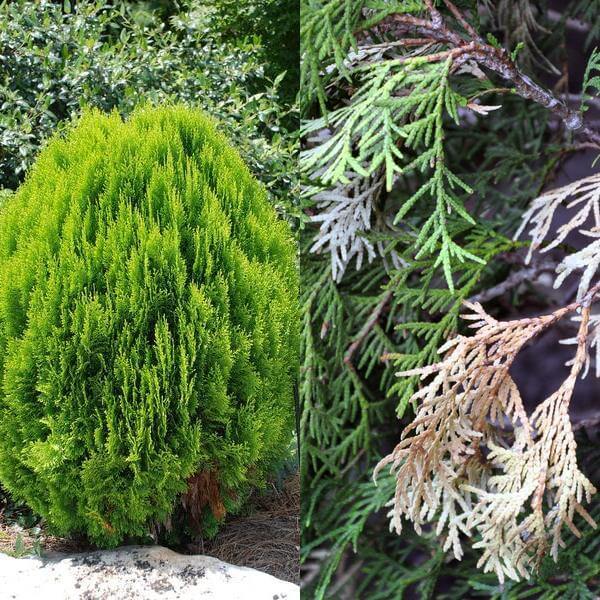

Certain species of conifers with variegated leaves are capable of losing their color over time. You can fix this by trimming. So, for example, a cypress tree, after the crown formation procedure, turns into a thicker plant with luxurious silvery needles. But if you forget about pruning the plant, then it will stretch out, the trunk will become bare, and the lower part of the tree will turn yellow.
Junipers and yews should be pruned in early spring. In doing so, it is recommended to cut off large side shoots.
It is also advisable to prune conifers, which are in the shape of a ball, at the beginning of the spring period.
In pines, active growth begins in summer. During the pruning procedure, you need to use a pruner and cut off parts of the lateral young shoots with it, without damaging the lateral buds, since other shoots will then grow from them.
Large trees should be pruned carefully. It is advisable to inspect it around in advance. And it is best to start the process from the top, leave the tree in this form for several years, and later trim the side shoots and start forming the crown. It is not recommended to remove old branches for amateur gardeners, since the tree is sick for a very long time after that and may die.
Video footage on how to properly prune conifers can be seen below.
Hello everyone, my name is Natasha! I love plants and decor. I make florariums, collect a collection of plants, maintain a pharmacy "vegetable garden", and also maintain a blog lovgarden for everyone who is passionate about the theme of the garden, vegetable garden and plants as much as I am.
Inoculation of blue spruce on common spruce
For the propagation of rare and hard-to-root varieties of conifers, experienced gardeners use the grafting method. It is good in that it gives a high survival rate when the procedure is carried out correctly:
- When choosing a stock, for example, a common spruce Push, you can take both young trees and those whose age exceeds 5 years.
- Healthy apical shoots are chosen for the scion.
- If the daughter stalk is much thinner than the parent branch, then the lateral split method is used. With a strong scion, it is placed on the side in the butt.
- Fasten the branches with a woolen thread coated with wax.
- A greenhouse is built over the plants for a month, which is aired for only a few minutes a day.
Timing of pruning trees and shrubs, conifers


Spruce: 2-3 decade of June at the time of laying future buds. Almost all ate trees tolerate pruning and shearing well, but the condition: the plants must take root after transplanting, otherwise they will hurt. Shearing is carried out up to 3-year-old shoots, since the laying of new shoots occurs on shoots not older than 3 years of age.
Larch: molding in early spring. Haircut, pruning: summer, autumn.
Juniper: from early spring to mid-August.
Fir: formation in early spring and June during periods of inactive resin movement.
Pine: shaping: spring before bud break. In early June, haircut on the green mass (when young needles are up to 1 cm long). From mid-July from the moment of laying new buds. New shoots are laid only on shoots covered with needles no older than 2-3 years old. Therefore, when pruning for renewal, it is necessary to leave shoots of 2-3 years old. New buds are laid in place of needles (each needles can potentially become a shoot), predominantly located as close as possible to the place where the shoot is cut. By adjusting the number and location of needles after pruning (plucking out excess needles), you can regulate the number and place of formation of new shoots. New buds are laid after the young shoots have finished growing in length (early June). A haircut on the green mass must be carried out within these periods, otherwise, after the haircut, the laying of new buds will not occur. And, conversely, if after pruning (removing lignified shoots) we do not need the formation of additional buds, then pruning is carried out either in the spring before bud break, or from mid-July, after laying new buds.
Thuja: early spring, early summer.
Aronia: Shaping, sanitary pruning: spring. Main pruning: autumn, after fruiting.
Barberry: in early spring. Dead shoots are cut in the middle of summer. Only dry, damaged and thickened branches are cut out, elongated shoots are shortened.
Euonymus: molding: spring, autumn. Main pruning: May, September. Sanitary pruning: October.
Hawthorn: molding, sanitary pruning: April. Main pruning: summer.
Heather: April.
Weigela: shaping, sanitary: spring, autumn. Main: after flowering (July).
Hydrangea (shrub): Large-leaved: in areas with a cold climate, wilted inflorescences are left for the winter to protect young growth. Pruning them in mid-spring. Paniculata: pruning: March. In order for the hydrangea to bloom profusely, the inflorescences are large, in the spring, last year's shoots are shortened to 2-3 pairs of buds.
Doren: shaping, pruning: March-early April. Summer: supportive haircut.
Honeysuckle (shrub): - Tatar honeysuckle: in the middle of summer, after flowering. Honeysuckle brilliant in hedges 3 times per season from spring to autumn.
Iva, Irga: shaping: spring, autumn. Main pruning: April. Sanitary pruning: annually.
Kalina: - shaping: spring. Main pruning after flowering: April. Sanitary / Anti-aging Pruning: March to early April.
Cotoneaster: formation: early spring. Summer: supportive haircut.
Lavender: In the spring, in the fall, pruning. If you cut off the faded inflorescences, then in September, re-flowering.
Hazel: molding: early spring and autumn. Sanitary / Anti-aging Pruning: Annually in Spring.
Bloodroot: shaping: spring, summer. Main / sanitary / anti-aging: annually, autumn.
Tree rejuvenation
Conifers that have been on the site for more than 10 years have many dry and bare branches. Such branches must be removed, which stimulates the growth of new shoots. The purpose of rejuvenating pruning is to hinder the growth of shoot ends, as this leads to the appearance of long shoots that are not covered with needles.
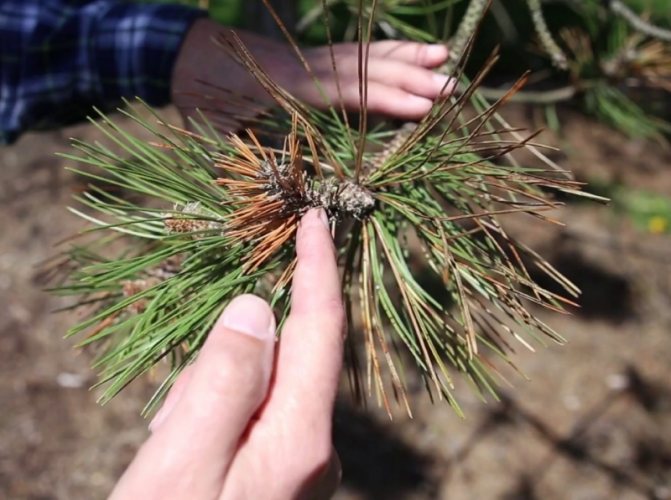

Rejuvenation is performed as follows:
- in mid-September, the ends of bare old branches are cut off. This circumcision stimulates dormant kidneys;
- large processes that are not endowed with a growth point are eliminated;
- in early spring, pruning of non-viable shoots located in the lower part of the crown is done;
- the branches are cut so that the needles remain on the remaining part, which will prevent them from drying out.
Thanks to rejuvenating measures, new needles and young shoots will appear on the coniferous tree. Anti-aging pruning is done after three years.
How not to get a house under the tree: all about pruning and shaping conifers
Adding an article to a new collection
Quite often, conifers or shrubs can be found at their summer cottage. To make them the pride of the owners, we must not forget about their pruning. This group of plants grows slowly, so they will not require much attention from you.
To properly care for plants, you need to know some of their features. Conifers have been living on Earth for about 300 million years. Currently, there are more than 600 species of them. Despite the fact that conifers belong to the same class, they differ from each other both in appearance and in growing conditions.
Common spruce pests
No less concern to gardeners is also caused by pests of conifers:
- spruce false shield;
- spruce needle-eater
- sawyer.
When detecting malicious activity, you must:
- Assess the cultivation technique. The tree may be lacking sun or moisture.
- Dig in the trunk circle
- The common spruce Akrokona, when infected, is necessarily treated with broad-spectrum insecticides, for example, "Iskra", "Alatar".
Conifers at their summer cottage
Conifers are a special group of plants in which the cone is the place of seed formation. At the word “needles”, many immediately imagine a thin, needle-like “leaf” of some trees: spruce, pine, larch, etc. However, needles are also called scaly flat leaves, for example, thuja or cypress. The latter also belong to the group of conifers. The bulk of this department is trees, but there are also shrubs: juniper, cypress, etc.
Another distinctive feature of many conifers is the presence of resin. This substance is necessary for plants to protect against all kinds of insects and pathogens of fungal diseases. At high temperatures the resin becomes soft, at normal temperatures it hardens.
Everyone knows amber - this is also a common resin of coniferous trees. Its value is that it was formed 20-100 million years ago.
Recently, conifers have begun to gain more and more popularity among summer residents. On the plots, juniper, thuja, pine and spruce are quite common. These trees and shrubs attract gardeners with their ease of care and a decorative appearance that persists throughout the year: most conifers are evergreens.
Diseases of the common spruce
Ornamental conifers, such as the Little Jam spruce, have a stable immunity to all kinds of pests and diseases, but they also have their own diseases:
- Schütte
... This is a fungal infection of the needles. It manifests itself in a change in hue from green to red or brown. In the affected areas, needles fall out over time, and the branches become covered with a black bloom. If such symptoms are found, the affected plants are treated with fungicidal solutions every two weeks. Falcon and Quadris have proven themselves well. - Fusarium
is a fungal disease affecting the root system. From this, the needles begin to dry and fall off. It is almost impossible to cure the disease on your own. It is better to turn to professionals who will offer to make stem injections and carry out an etching of the area. - Rust
... The first signs of the disease are yellowing and falling of needles, and then whole branches. Each needle is covered with a kind of yellow bubbles. To combat the disease, plants are sprayed with fungicidal preparations "Fitosporin-M", "Abiga-peak".
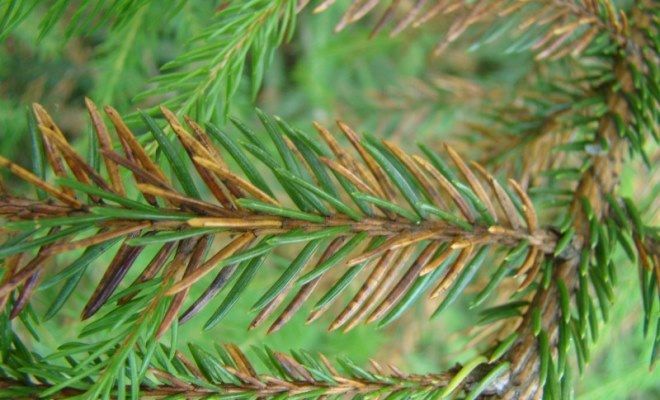

Why do conifers and shrubs need pruning?
Why prune conifers and shrubs? There may be several reasons:
- You want to keep the tree from growing. Without pruning, the plant will reach the height that nature laid in it. For example, a 20-year-old pine tree may well grow up to 6 m. If you control its growth, you can “keep” the tree within 2-2.5 m.
- It is necessary to emphasize the appearance of the plant.Young shoots sometimes give the bush a sloppy look, so they should be removed.
- You want to give the bush some shape. It can be as simple as a cube, pyramid or cone, or as complex and bizarre. Masters of landscape design even create figures of animals and people from conifers.
- You don't like too much distance between shoots. Correct pruning will help make the crown thicker and thus add decorativeness to the plant.
- You find sick, broken or dry branches on the plant. They must be deleted without fail.
Norway spruce in landscape design
Conifers can be used in different ways to decorate the site:
- In large areas, it is recommended to plant large trees, which, as they grow, will become a counterweight to the house or estate.
- From medium-sized varieties, a beautiful hedge is obtained from ordinary spruce. Its height can be adjusted independently by trimming and pinching.
- Dwarf varieties look good in compositions of alpine slides and mixborders, on the slopes of dry streams.
Rules for pruning conifers
Trimming refers to both a haircut and a formative trim. First, let's differentiate between the two. Crown formation is quite stressful for the plant, because in this case most of the shoots are immediately removed. Trimming involves trimming a small portion of the branches lightly and less traumatically. This procedure is essential to maintain the shape and health of the plant.
When pruning conifers, you should always adhere to the golden rule "Think seven times - cut once!" By improper pruning, you can harm conifers.
Basic rules to follow when pruning conifers and shrubs:
Rule 1. Once the crown has formed, you will have to trim the conifers every year. If you are not going to do this, it is best not to start at all. Anyway, without pruning, your plant will return to its original appearance after a while. So why injure the branches again?
If you want your pet to grow dwarf, you need to start shaping as early as possible.
Rule 2. It is possible to start forming the crown only in an absolutely healthy tree and only after the first year of life. If you see signs of illness or the plant is not very strong, help it first. Top dressing with mineral fertilizers and reasonable watering - no more than 2-3 times a month - will strengthen the plant. When it “gets better”, you can start trimming.
Conifers are more fond of sprinkling - irrigation of the crown than watering at the root.
Rule 3. Do not cut more than a third of the green mass in one run.
Rule 4. When formative pruning, try to focus on the natural shape of the plant. For many conifers, it is enough to just slightly correct the natural shape so that they become decorative.
Rule 5. Do not prune the shoots on a hot day. This can cause increased moisture evaporation. Wet and cold weather is also not the best time to prune. During such periods, pathogens of fungal diseases are activated, and a plant weakened by pruning can get sick. It is better to choose a dry, non-sunny day for this procedure.
Rule 6. Be sure to leave the part of the branch on which there are needles when pruning. Conifers, unlike fruit plants, do not have dormant buds on bare branches. Therefore, new greens will not appear there - the branch will simply dry out.
Rule 7. All work with conifers should be carried out in protective clothing. First, many conifers are poisonous plants. Gloves will protect you from toxic substances. Secondly, when cutting, resin is released, which cannot be washed off. The clothes will most likely have to be thrown away afterwards.
Do not chase beautiful exotic plants. In our harsh conditions, it is difficult to look after them.You can give the same shape to conifers growing in our climatic zone. They are both cheaper and more durable.
What else do you need to know about decorative pruning of conifers and shrubs?
Advice 1. Experts do not recommend removing the one-year growth with pruning shears. needles can be damaged. Better to do it with your hands: just pinch off the soft shoot. In a few months, active formation of shoot buds will begin at this place.
Tip 2. If during formative pruning it becomes necessary to remove lignified shoots, take a hacksaw. After trimming, resin will begin to emerge at the cut site. It will clog the blood vessels and protect the plant from infection. A pruner or scissors will leave a "lacerated" wound, which will then heal for a long time.
Tip 3. If you want to get a dense and compact crown in the future, you need to remove at least 2/3 of the young shoots. If you need long branches, remove 1/3 of them.
Follow our advice and your conifers will become even more attractive.
Conifers: don't be afraid to prune
Worldwide conifers - a favorite object for topiary haircuts. It is not difficult to care for them, they are decorative all year round, varied in shape and color. But the main thing is that conifers, as a rule, tolerate a haircut well and grow slowly, so you do not have to use scissors often.
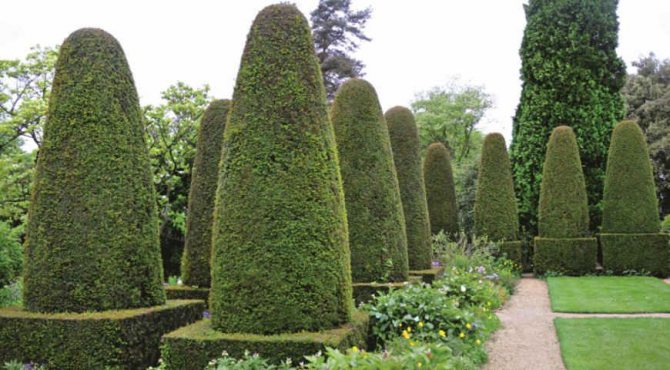

The best examples of topiary art can be seen in the famous garden at the Levens Hall estate in England. Lions, chess pieces, peacocks, geometric yew compositions have been growing here for at least three centuries. And they still inspire gardeners to create their own home masterpieces.
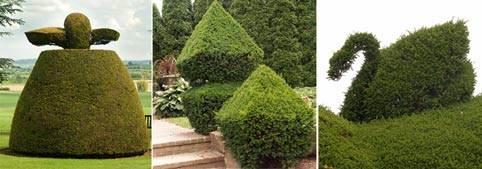

You can create topiary objects of any complexity from conifers. From species with plastic, flexible branches - even intricate figures of animals and people, letters and numbers. But beginners should not set themselves the goal of turning an overgrown thuja or juniper bush into an unknown animal. First you need to master the hairstyle of simple geometric shapes - a ball, a cube, a pyramid, a cylinder, a cone. And only then start creating spirals, arches, bersot and other art objects.
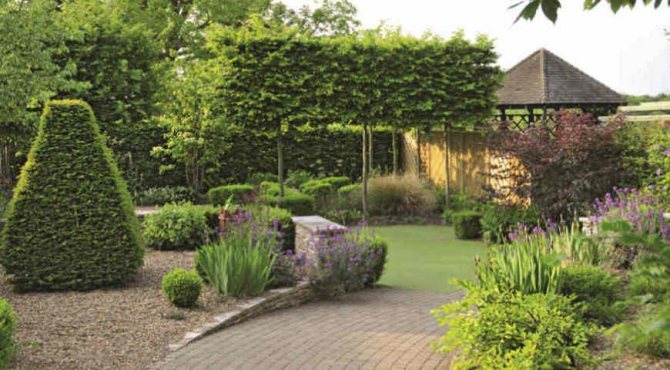

Conifer cutting rules
- Plant formation can begin no earlier than a year after planting or transplanting. For trimming, select specimens that are in the best condition, preferably acclimatized plants or species from the local flora. For example, if spruce trees feel good in your region, then you can safely plant them on the site and embody your artistic ideas.
- When choosing a topiary form, one should focus on the natural shape of the crown. Often it is enough to simply emphasize the shape laid down by nature with scissors, so that a complete composition appears in the garden.
- For one haircut, you can remove no more than 1/3 of the green mass. After all, this is still stress for the plant. But in order for the crown to become thicker, at the end of the season it is imperative to cut off a third of the growth of the current year, simply repeating the already existing crown shape.
- When cutting, you should not leave bare branches devoid of needles. Unlike most deciduous plants, conifers do not have dormant buds, and therefore a bare branch will not be covered with greenery, but will simply dry out.
- Many of the conifers are poisonous - for example, most species of thuja, juniper, yew. Therefore, gloves are required when working. Also, do not forget that the resin that stands out during a haircut is practically not washed off.
- The trimming tool must be sharp and clean. In addition, it is advisable to wipe the blades several times during the clipping process.
- After work, the cutting surfaces should be washed with warm water and soap or cleaned with special products.
In order for the plant to better tolerate the topiary haircut, you need choose the right time... In general, it is possible to cut conifers in Russia from early spring to late autumn. The main criterion - average daily air temperature: it must not be lower than 4 ° С. Each type of conifer has periods of active growth, when resin is released abundantly, and at this time the plants should not be disturbed. The strongest outflow of resin occurs in early spring and summer, and more precise timing depends on local conditions and the characteristics of a particular species. Therefore, for beginners for the first experiments, it is better to choose the second half of summer and autumn.
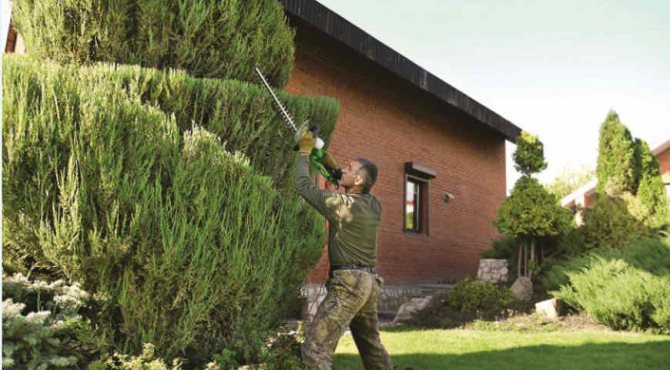

Care before and after haircut
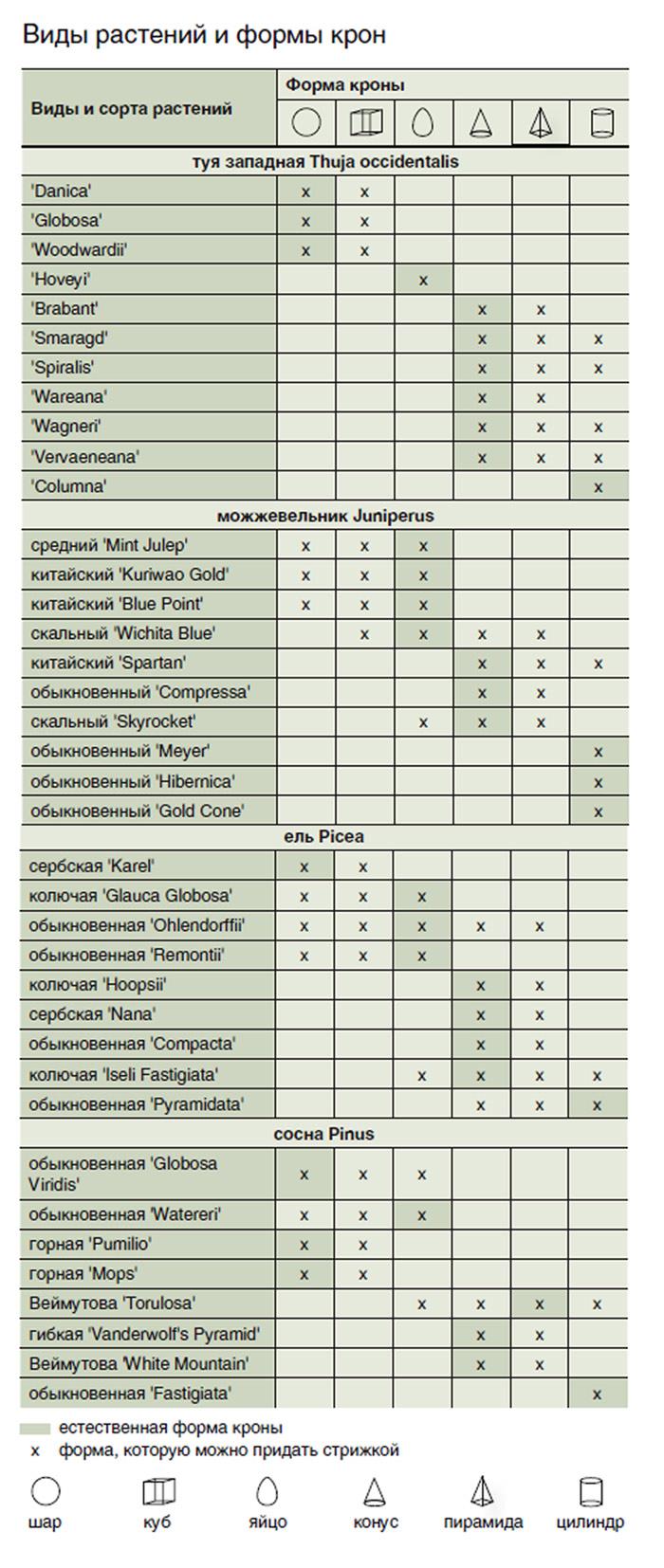

If you have a few conifers on your site and they are not in the best shape, and you really want to give them a designer look, then first you need to strengthen the vitality of the plants. This is easy to achieve with the help of fertilizing and proper agricultural technology. Keep in mind that over-watering can be just as harmful to conifers as drought. In general, conifers love watering on the crown, sprinkling. After trimming, it is advisable to support the plants with stimulants and adaptogens. Spray epin on the crown, and use zircon to stimulate root formation. Read the instructions before using the drugs. Often it is not necessary to cut conifers. Usually 1-3 maintenance haircuts are required per season. And don't throw away “production waste”. If you cut spruce in the fall, then you get an excellent covering material - spruce branches. It is useful for sheltering roses, young seedlings, vines. Many books have been devoted to the principles of topiary haircut of simple forms. One of the best is Heinrich Balti's “Curly Trimming of Trees” (2008 edition). In it you will find both good drawings and a detailed description of the methods and methods of haircuts.
Illustrations to the material: Tatiana Shkondina, Vladimir Lyapichev

